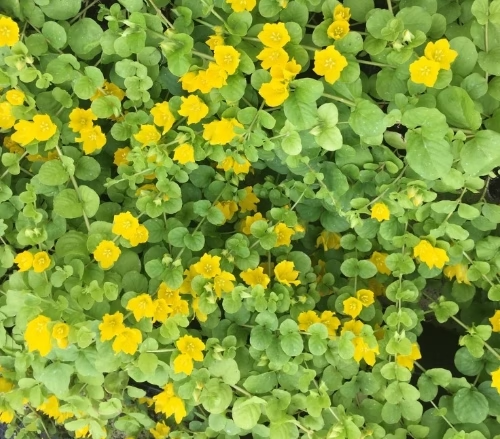
Creeping Jenny
Botanical Name
:
Lysimachia nummularia
Plant Type
:
Evergreen, herbaceous perennial ground cover
Seasons
:
Year-round, active growth in spring and summer with flowering in late spring to early summer.
Sun Level
:
Full sun (6+ hours) to partial shade (can survive in deep shade but grows slower).
Ideal Soil Temperature for Planting
:
Done best when the soil can be worked.
Soil Type
:
Adaptable to well-draining sandy, loamy, or clay soils.
Germination
:
Primarily propagated by division or cuttings, seed germination is slow and uncommon.
P.H. Level
:
Slightly acidic to neutral (6.0–7.5).
Water/Irrigation
:
Prefers moist but well-drained soil. Consistent moisture enhances growth but avoid waterlogging.
Fertilization
:
Not necessary unless using a balanced fertilizer lightly during the growing season.
Habit
:
Low-growing, trailing, spreading via creeping stems that root at nodes.
Final Plant Height
:
2–4 inches (5–10 cm)
Spread
:
12–36 inches (30–90 cm) or more, depending on conditions.
Spacing
:
12–18 inches (30–45 cm) apart for ground cover.
Flowers
:
Small, bright yellow, cup-shaped flowers in late spring to summer.
Attracts
:
Bees, butterflies, and pollinators
Uses
:
Ground cover, erosion control, hanging baskets, container gardens, water gardens, pathways
Companions
:
Hostas, ferns, astilbes, coral bells, sedum
Pruning
:
Regular trimming back after flowering if desired for aesthetic purposes. Removing dead foliage helps maintain appearance but isn’t essential since it remains evergreen in mild climates.
Toxicity
:
Non-toxic to humans and pets
Pests
:
Generally pest-free but may attract aphids or slugs.
Diseases
:
Root rot in overly wet soil, occasional fungal leaf spots.
Fun Fact
:
Creeping Jenny is also known as “moneywort” due to its coin-shaped leaves which resemble tiny coins.
Additional Info
:
This plant is deer-resistant and makes an excellent filler in mixed container plantings, cascading beautifully over the edges.
Botanical Name
:
Lysimachia nummularia
Plant Type
:
Evergreen, herbaceous perennial ground cover
Seasons
:
Year-round, active growth in spring and summer with flowering in late spring to early summer.
Sun Level
:
Full sun (6+ hours) to partial shade (can survive in deep shade but grows slower).
Ideal Soil Temperature for Planting
:
Done best when the soil can be worked.
Soil Type
:
Adaptable to well-draining sandy, loamy, or clay soils.
Germination
:
Primarily propagated by division or cuttings, seed germination is slow and uncommon.
P.H. Level
:
Slightly acidic to neutral (6.0–7.5).
Water/Irrigation
:
Prefers moist but well-drained soil. Consistent moisture enhances growth but avoid waterlogging.
Fertilization
:
Not necessary unless using a balanced fertilizer lightly during the growing season.
Habit
:
Low-growing, trailing, spreading via creeping stems that root at nodes.
Final Plant Height
:
2–4 inches (5–10 cm)
Spread
:
12–36 inches (30–90 cm) or more, depending on conditions.
Spacing
:
12–18 inches (30–45 cm) apart for ground cover.
Flowers
:
Small, bright yellow, cup-shaped flowers in late spring to summer.
Attracts
:
Bees, butterflies, and pollinators
Uses
:
Ground cover, erosion control, hanging baskets, container gardens, water gardens, pathways
Companions
:
Hostas, ferns, astilbes, coral bells, sedum
Pruning
:
Regular trimming back after flowering if desired for aesthetic purposes. Removing dead foliage helps maintain appearance but isn’t essential since it remains evergreen in mild climates.
Toxicity
:
Non-toxic to humans and pets
Pests
:
Generally pest-free but may attract aphids or slugs.
Diseases
:
Root rot in overly wet soil, occasional fungal leaf spots.
Fun Fact
:
Creeping Jenny is also known as “moneywort” due to its coin-shaped leaves which resemble tiny coins.
Additional Info
:
This plant is deer-resistant and makes an excellent filler in mixed container plantings, cascading beautifully over the edges.
Written by Salome Wapukha – https://www.linkedin.com/in/salome-wapukha-556700193/

